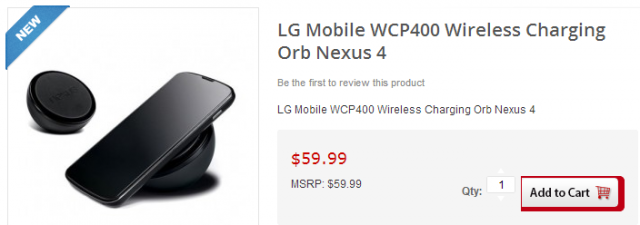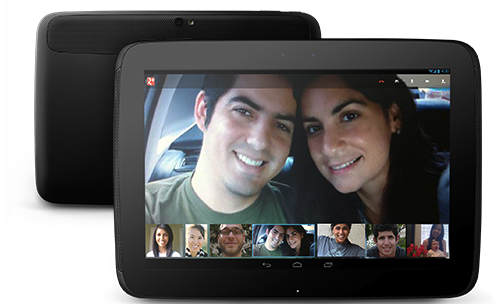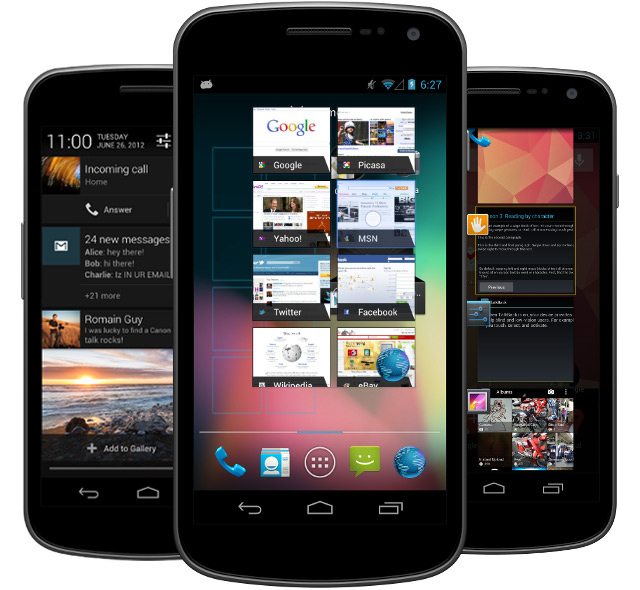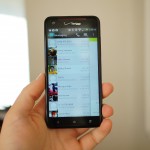Android Phone Fans |
- 40% of Blackberry 10′s apps are repackaged Android APKs
- Retailer accepting Nexus 4 wireless charging orb pre-sales
- Yelp for Android update brings 3D Google Maps
- Nexus 10 stock normalizing in the Google Play Store
- Apple denied second shot at banning Samsung Galaxy Nexus
- T-Mobile Galaxy S2 and Galaxy S3 get maintenance upgrades
- Hands-on with Sliding Messaging – A better way to text message [VIDEO]
- Verizon bolsters DMV coverage with completion of $301 million network enhancements
- Pigs fly as Verizon readies Ice Cream Sandwich rollout for the HTC Thunderbolt
- Intel, Acer come together to unveil the Liquid C1
- Google Glass sitting at the FCC
- Samsung solidifies commitment to S Pen with 5% stake purchase in Wacom
- Last chance to get an OUYA console in April
- Temple Run 2 surpasses Angry Birds’ record, reaches 50 million downloads
- Sprint updates HTC EVO 4G LTE, brings MHL support
| 40% of Blackberry 10′s apps are repackaged Android APKs Posted: 31 Jan 2013 06:44 PM PST You may have heard the folks at Blackberry touting that its apps store will have about 70,000 for Blackberry 10′s launch, but how, exactly, did it build up such a massive catalog? It wasn’t pure, raw development, I can tell you that much. Many of those applications were developed for the older versions of Blackberry, but a whopping 40% — that’s about 28,000 — came from somewhere else. Those applications actually came from Android. If you don’t remember from the launch of the Blackberry Playbook, Blackberry — who was formerly known as RIM — provided a tool that allowed developers to easily port and repackage their Android apps to work on BBOS. With the recent announcement of Blackberry 10 you had to imagine the company would look to implement the same sort of compatibility layer for the phone side of things. Interested developers need only change a few lines of code in order to port their Android apps over to Blackberry. Most of the code deals with implementing the “back” and “menu” functions which are normally handled with hardware or software buttons. Since Blackberry 10 uses swiping gestures to control all of that it is necessary for developers to make those minor tweaks. It’s nearly effortless, though, and the end result is a Blackberry app that actually is an Android app. Blackberry obviously wants developers coding in the platform’s native tongue, but the company needed to spur development as quickly and efficiently as possible, and offering a tool to port apps from the world’s fastest growing mobile platform is one neat way to do that. It’s a band-aid, essentially, and Blackberry will want developers to rip it off as soon as possible and let the wounds of the app-less platform (when it comes to modern implementations, anyway) heal naturally. [via PCMag] |
| Retailer accepting Nexus 4 wireless charging orb pre-sales Posted: 31 Jan 2013 06:03 PM PST We’ve been wondering when we might be able to get our hands on the wireless charging orb for the Nexus 4. While we still don’t have a clear idea of when to expect it we can at least take solace in the fact that we’re close enough that pre-sales are now being accepted. PureMobile listed the device earlier today, and it initially indicated the accessory was out of stock. That listing has since been changed for the purposes of selling the device ahead of launch. The retailer put out a shipment estimate of 2-4 weeks, though if the Nexus 7 desktop dock was anything to go by then we won’t put too much stuck into the estimation until it actually begins arriving at users’ doorsteps. This is quite the perfect timing as Google has seemingly received a ton of Nexus 4 stock to facilitate the insane demand that followed its launch. Many customers have been able to submit orders for the phone, and some have even already gotten shipment notifications. Wireless charging is nothing new, but this particular device is quite sexy looking and it acts as a stand for the Nexus 4 when propped upright. You can put the device on it in either portrait or landscape orientation so unless you need extra multimedia capabilities this pretty much solves a lot of folks’ issue of needing a desktop dock. You’ll be able to kill those two birds with just one $59.99 stone, but since we can’t vouch for the reliability and track record of PureMobile we’ll remind you to place your order with caution (it looks safe enough, but you never know). Head there to get started. [Thanks James!] |
| Yelp for Android update brings 3D Google Maps Posted: 31 Jan 2013 04:59 PM PST Yelp for Android’s built-in mapping feature has long been outdated, but a brand new upgrade in the Google Play Store has updated the app’s integration to use Google Maps v2. What this brings is the vector-based mapping that we enjoy in Google Maps, which means we’ll finally be able to explore listings in the map view using the 3D topography feature. Alongside the new maps, Yelp’s update should bring us improved loading times and the general round of bug fixes and performance improvements. Perhaps it’s not the ground-breaking experience-changing update some are looking for, but since maps is as big of a feature as any in this type of app this is pretty monumental for the Yelp faithful. Go ahead and grab it at the source link ahead. |
| Nexus 10 stock normalizing in the Google Play Store Posted: 31 Jan 2013 04:47 PM PST Google surprised the hell out of everyone when it replenished stock of the Nexus 4 almost everywhere (and even able to fulfill orders as of the time of this writing). That particular device hasn’t been the only tricky one to get your hands on, though. Those looking for the Nexus 10 have also had a bit of trouble, though it looks like stock might be normalizing for that particular device, as well. Both the 16GB and 32GB units are showing up as in-stock and shipping soon, with a 1-2 week waiting period between ordering and shipping. Folks might get lucky even with the waiting period as those who weren’t expecting the Nexus 4 for 1-2 weeks began to see shipment notifications right away. Google has struggled to keep up with demand for its aggressively priced handsets and tablets ever since they’ve launched, though we’ve had a hard time putting our finger on why, exactly, that is. Rumors say Google’s initial order was ridiculously low, which indicates the company didn’t properly gauge demand ahead of launch. Whether or not that is true is something we’ll probably never get the answer to, but neither side of this equation — bet it Google or the manufacturers — was looking to do any finger pointing. All is well that ends well, though. Head to the Play Store and order yourself a Nexus 10 if you’ve been desiring one, and be sure to get your hands on a Nexus 4 if you’ve been waiting on that — you never know how long they’re going to last this time. |
| Apple denied second shot at banning Samsung Galaxy Nexus Posted: 31 Jan 2013 03:53 PM PST While the Samsung Galaxy Nexus is no longer the new kid on the block — the Nexus 4 has supplanted it despite troubles with availability — Apple would still like to see it off the market. It looks like the Cupertino manufacturer won’t get the satisfaction of seeing that happen, though, as a US appeals court judge has officially reiterated that it would not impose a sales ban on the Galaxy Nexus. The original ruling — made by the controversial US District Judge Lucy Koh — gave Apple what it wanted, but the affects of the ban were unnoticeable as Samsung used appeals processes and grace periods to its advantage. Koh later denied Samsung a temporary lift on the injunction, but her decisions were overturned by the Federal Court of Appeals. The courts maintained that Koh and the district court of California abused their discretion in making the original decision, and it reaffirmed that with today’s decision. It’s unclear where the Apple vs Samsung saga will go from here. Samsung has worked to ensure its new products don’t infringe on any of Apple’s patents and copyrights, and has issued updates to older phones to bring them into compliance. Apple enjoyed minor victories in places like Germany, but many of those decisions were made irrelevant by several factors. We have a feeling that Apple’s stubbornness won’t subside anytime soon, but at this point it just seems like time and money is being drained into these cases as Samsung successfully dodges every malicious attack thrown its way. [via Wired, thanks to everyone who sent this in!] |
| T-Mobile Galaxy S2 and Galaxy S3 get maintenance upgrades Posted: 31 Jan 2013 03:26 PM PST A pair of Samsung phones for Magenta are in line to receive some quick software upgrades starting today, it seems. The Samsung Galaxy S2, the 2011 sensation, will receive an upgrade that will apply a “Qualcomm fix,” and will also bring improvements to S Voice/Vlingo. Other security updates, bug fixes and device enhancements have been made, though those particular changes aren’t being detailed at the moment. And no, this doesn’t take us beyond Android 2.3.6 — we hear that particular update is in the works for at least the international version, but whether or not it comes to T-Mobile’s is still up in the air. This would appear to be the same upgrade we saw rolling out starting last week so if you weren’t able to catch it back then you should be good to go today. Samsung’s shining star of 2012 — the Samsung Galaxy S3 — is also receiving an upgrade, though its changes seem a tad more mild in comparison. We’re told to expect an improved user experience, and without T-Mobile’s willingness to go more in-depth about that we can only assume that means some bugs have been squashed and the obligatory performance enhancements have been made. Galaxy S2 owners will need to set aside 11MB for their download, while those on the Galaxy S3 will only need about 4MB of bandwidth to pull theirs down. As a general rule of thumb, try to make sure your battery is at 50% before accepting the upgrade, and make sure you read up on the other prerequisites (check the source links) to make sure things go off without a hitch. |
| Hands-on with Sliding Messaging – A better way to text message [VIDEO] Posted: 31 Jan 2013 03:11 PM PST If there’s one complaint you can make with Android, it’s that it can occasionally be inconsistent. Take Google Talk and the stock messaging app. 2 different apps that essentially do the same thing. Only one accesses manages your SMS messages, while the other handles your instant messages. But why do they behave so differently? Both have a list view to access conversations, but when inside a convo, I love the way Talk allows you to quickly swipe between conversations without having to go back to revisit the main list view. It may sound small — but why can’t the SMS perform in the same way? Well, now it does with Sliding Messaging. The app is new to the Play Store and adds a new way of interacting with a messaging application more consistent with other Android apps. The UI follows Google’s design guidelines and looks almost no different from the stock Android messaging application. The real difference lays in the way Sliding Messaging behaves. While in a conversation, you can slide between conversations with the swipe of a finger, same as on Google Talk. Nothing revolutionary, but messaging multiple friends and family has never been easier. To get to your full list of conversations you wont have to deal with Android’s inconsistent back button. Simply swipe from the left edge of the screen and you’ll be presented with a full list of your convo’s. Grab the right side of the screen, and you can quickly compose a new text message. It’s glorious. The app features a plethora of settings, to tailor the app to your tastes including a handy popup, for quickly answering SMS messages without exiting your current application and opening the messaging app. My only complaint is the app can be a little slow to load, whether it’s still in RAM or completely closed out. Keep in mind the app is still in its early stages, so there’s still room for improvement. The free version of Sliding Messaging wont give you access to MMS (picture) messages, that’s only provided in the $1 Pro version (same price as a Value Menu McDouble). |
| Verizon bolsters DMV coverage with completion of $301 million network enhancements Posted: 31 Jan 2013 02:45 PM PST Verizon’s on a roll this fine Thursday. It launched the new Jetpack MiFi 5510L, surprised Thunderbolt users with news regarding an impending Ice Cream Sandwich update, and now it has announced a major network enhancement project that cost the carrier $301 million. That project benefits users across the DMV — that is, Washington, D.C., Maryland and Virginia — and brought improvements for both 3G and 4G performance. Since the year 2000, Verizon has spent a ridiculous $3 billion to continually improve regional performance in the area. It’s Verizon’s hometown, after all, so you have to expect them to pay extra special care in their area of operation. Verizon has spent far more on its nationwide rollout of 4G and enhancement of 3G, though. Those efforts allowed Verizon to reach the milestone of 470 4G LTE markets this past December, and that number will only continue to rise from today. Big Red’s aspirations have already been set as the carrier expects to cover a vast majority of its 3G footprint with 4G LTE by the end of this year. Other carriers aim to have their networks largely deployed by then, as well, but they will have a lot of work to do to catch up to Verizon. T-Mobile’s situation is the most interesting of them all — its only activity has been a limited launch in Las Vegas following the CES festivities, and rumors that the network is being tested in parts of Wichita, Kansas. The company hasn’t even unveiled any LTE-compatible devices yet, though we hear the Samsung Galaxy S3 will get refreshed with the radios in tow. Sprint and AT&T are steadily building compelling device line-ups, but the two are still lagging behind Verizon when it comes to coverage. Both seem confident that their goals can be reached, though, so we’ll have to take their word for it until we look for a status report at the end of the year. For now, Verizon still seems to be the king of 4G. Read on for full press details.
|
| Pigs fly as Verizon readies Ice Cream Sandwich rollout for the HTC Thunderbolt Posted: 31 Jan 2013 01:59 PM PST This is probably the last thing I’d have ever expected to see in the news wire today. The HTC Thunderbolt is coming up on its two-year anniversary, and we figured the device had simply been abandoned by Verizon. It was the first 4G LTE phone, sure, but its launch was plagued by poor battery life and some nasty bugs, and the lack of Ice Cream Sandwich — after nearly a year of availability — didn’t help. Welp, it looks like although the phone seemed to exist at the very bottom of the 4G LTE totem pole, Verizon finally got around to delivering Ice Cream Sandwich for it. Most people wouldn’t be satisfied until they got Jelly Bean, but if you happen to still be rocking your HTC Thunderbolt after all this time then you’d better jump for joy and take a day off of work for Ice Cream Sandwich. Some of the changes the Ice Cream Sandwich update will provide include the ability to access the notification bar via the lock-screen, the ability to swipe individual notifications away to get rid of them, the ability to customize the home-screen’s launch bar, a face unlock mechanism, the new ICS-style apps switcher and more. Users will be on the lookout for firmware 7.02.605.06 710RD, Android version 4.0.4 and HTC Sense 3.6, and the update will be close to 400MB — you can put that old 4G LTE workhorse to work if you still have unlimited data, but getting on WiFi would be the far wiser choice. Unfortunately we’re not sure when, exactly, the upgrade will beam itself to handsets everywhere, but we’ll be on the lookout for its arrival in the days and weeks to come. |
| Intel, Acer come together to unveil the Liquid C1 Posted: 31 Jan 2013 01:27 PM PST Intel seems to be spreading its x86 seed quite fine in the low-end smartphone market, but another handset aimed at the mid-range market with its latest chipset has been announced. This time, Acer decided to take the Atom z2420 and stuff it inside what they’re calling the Acer Liquid C1. The chipset isn’t a powerhouse compared to the S4s and Tegras of the world, but its attractive price/performance ratio is perfect for the entry-level handset that it is. The Liquid C1 will come equipped with a 4.3 inch qHD display, a 8 megapixel camera and will come pre-installed with Android 4.0 Ice Cream Sandwich. The aforementioned Z2420 is a 1.2GHz single-core chip with hyper-threading. There’s not much else going on, but the device boasts a very elegant design and a pretty respectable profile. Acer and Intel announced this thing in Thailand, and that’s the market that will get first dibs on it. Pricing will be set at 9,990 baht, about $335, and will be available starting next month. Other Asian markets are said to be in line for the device as well, though Acer wasn’t interested in sharing those particular details at this time. [via GSMArena] |
| Google Glass sitting at the FCC Posted: 31 Jan 2013 12:58 PM PST With Google’s Glass Foundry events taking place lately — one went down in San Francisco this past week, and a New York City event will commence tomorrow — you had to guess that the device is approved to be used and consumed in the United States, or at least close to that point. Sure enough, listings for the HUD-enabled glasses have been spotted inside the digital file drawers of the FCC. The publication of these documents don’t tell us anything that we haven’t already known or assumed. We do know that WiFi 802.11b/g will be on board and Bluetooth 4.0 will be an alternate wireless data option, but that’s about it right now. The bone-conduction technology we heard about in a recent patent filing does seem to be on board, as well. We’re glad to see that this wasn’t just a concept Google was dreaming up. It seems the paperwork was filed a couple of months ago, so it’s obvious Google requested a temporary hold to make sure one of us know what it was up to. Once this device makes its way through all of the necessary steps for approval Google will be able to legally distribute the devices in the United States. Of course, the only folks getting their hands on these glasses anytime soon are the developers who pre-ordered the early preview units at last year’s Google I/O. Phandroid plopped cash down for three of those if you don’t remember, though we’re still in the dark in regards to the arrival date. We’ll be waiting patiently for those details to roll in, but in the meantime we’re just happy to know that the device does look to be on track to be in the public’s hands — in one way or another — at some point this year. |
| Samsung solidifies commitment to S Pen with 5% stake purchase in Wacom Posted: 31 Jan 2013 12:21 PM PST Samsung’s been the biggest proponent of digitized displays and styluses ever since the original Galaxy Note reached shores everywhere, and with several devices out since then — including a possible 8 inch Galaxy Note said to debut next month — it’s become a huge part of Samsung’s mobile strategy. The Galaxy Note series has taken off and Samsung wants to make sure it has a more solid relationship with its partner Wacom. What better way to solidify said relationship than a purchase of a 5% stake in the company? That’s right, Samsung will fork over $58.9 million in cash to grab itself a small piece of Wacom’s legacy, giving it minority voting rights in the biggest digital stylus company you’ll find. In turn, Wacom will scratch Samsung’s back by funneling that money back into product research and development, improvements to their manufacturing process and enhancements to its supply systems so that it can serve Samsung even better. Samsung spear-headed the “phablet” movement back in 2011, but it wasn’t until the second edition of the Galaxy Note that things really took off. Not only did Samsung see huge success with the Galaxy Note 2, but its competitors have identified a budding market that seems ripe for the taking in 2013. This purchase gives Samsung an even sturdier leg up on the competition as they look to stay ahead of the smartphone curve with the innovation that the S Pen brings. Samsung is rumored to be bringing S Pen support to its Galaxy S line in due time, though we can’t say for sure those rumors are solid. We’re not even sure when, exactly, Samsung is looking to unveil the phone so our eyes are set on the Galaxy Note 8.0, a tablet that we should be seeing in the news by the time Mobile World Congress kicks off late next month. |
| Last chance to get an OUYA console in April Posted: 31 Jan 2013 10:54 AM PST
If you have been thinking about ordering yourself an OUYA, the Android-powered gaming console, act quickly if you want to be included in the first batch of shipments headed to buyers in April. The company has made a post to their Facebook page warning that stock will soon run dry, at which point potential buyers will have to wait for a second batch of consoles to ship at a later date.
In order to be among the first to receive the OUYA console, make sure you get your order in before February 4th. [via Facebook] |
| Temple Run 2 surpasses Angry Birds’ record, reaches 50 million downloads Posted: 31 Jan 2013 10:29 AM PST Temple Run 2 has surpassed Angry Birds Space to become the fasting growing mobile game by accruing over 50 million downloads in a mere 13 days since its release. The number takes into account downloads across the Google Play Store, Amazon Appstore and Apple App Store. Keith Shepherd, co-founder of Imangi, said, “the game has performed beyond our wildest dreams,” noting that, “Temple Run has evolved into something so much bigger than us.” The first installment in the series has been downloaded over 170 million times. At the current rate, there is no telling how much bigger the franchise could become. Temple Run and Temple Run 2 are both available now from the Google Play Store. [via Imangi] |
| Sprint updates HTC EVO 4G LTE, brings MHL support Posted: 31 Jan 2013 09:56 AM PST Sprint is pushing an update to their HTC EVO 4G LTE today bringing the phone’s software version to 3.16.651.3. The update addresses mostly minor issues with the handset, the most major changing being the implementation of audio/video output via an MHL cable. Bugs and tweaks include include improvements to the phone’s proximity sensor, WiFi connectivity, and Bluetooth compatibility. The update is arriving over the air, so it may not hit all users at once. You can check for updates by navigating to the ‘About phone’ screen under the Settings menu. [via Sprint] |
| You are subscribed to email updates from Android Phone Fans To stop receiving these emails, you may unsubscribe now. | Email delivery powered by Google |
| Google Inc., 20 West Kinzie, Chicago IL USA 60610 | |



















No comments:
Post a Comment